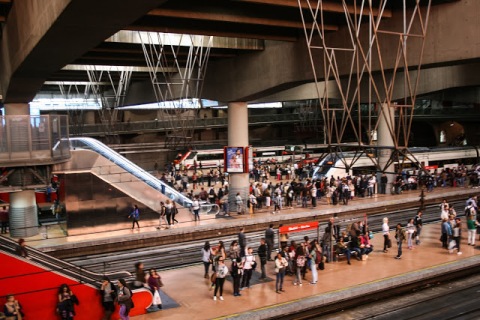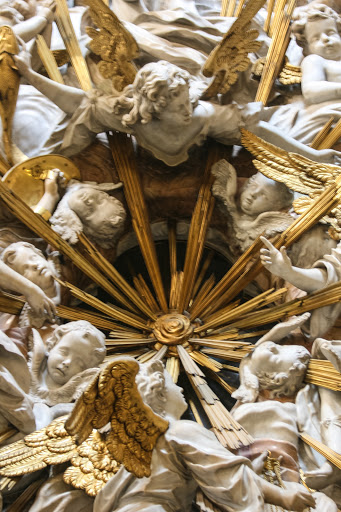Travels in Spain: Holy Toledo
November 1, 2015
“To appreciate Toledo one must see it from afar, for it is a mighty fortress on a rock.”
— James Michner, Iberia
“She stands only forty miles from Madrid, but there is a kind of indescribable solitude to her flavor, and the desolation of her hills, if scarcely utter, still is severe.”
— Jan Morris, Spain
Carol and I made a daytrip to Toledo on Spain’s RENFE high speed train, a 30-minute ride from Madrid. In our experience, the trains in Spain were punctual. I envy this transportation infrastructure and wish we had more options for traveling by train in the United States. Once we arrived in Toledo, we caught a bus up, and up, to the old city center.
“The wall which still partly encircles Toledo is a medieval wall, but it contains Roman stones, Gothic stones and Moorish stones, so that it is really a visible epitome of the city’s history.”
— H. V. Morton, A Stranger in Spain
” . . . the setting of Toledo is all abrasion — nothing soft, nothing amusing, nothing hospitable. This is the Spanish character at its most intractable. If a city can be said to look like a person, then Toledo looks just like one of those El Greco characters who were in fact conceived here — towering, handsome, humourless, sad, a little bloodless.”
— Jan Morris, Spain
We came to Toledo to see its cathedral, known in Spain as the “eighth wonder of the world.” But at first we caught just tantalizing glimpses of its spire as we tried to navigate the labyrinthine, narrow streets of the old city. We got lost, then lost again. Surely such an iconic and huge landmark like the Toledo Cathedral should not be that hard to find!!
“And surveying all, the culmination of this city, Toledo Cathedral stands like a vast testimonial of Spain’s divine destiny. The streets of Toledo are unbelievably tortuous, so narrow that along most of them a car cannot pass, and even a hand-trolley of oranges blocks the way; but when you have maneouvered your baffled way along them, have discovered the unremarkable outer walls of the cathedral, and have entered its unobtrusive cloister gate, then the immense expanse of the interior, its nave of seven bays and its twenty-eight chapels, seems to express the ultimate escape of the Spaniard from himself, via glory, to infinity. ‘Valour for God and Spain’ fills this great church like incense . . .”
— Jan Morris, Spain
“Toledo’s cathedral is huge, yet somehow elusive. You can get lost looking for it, then drop down an alleyway to buy a marzipan and suddenly find one of its great facades staring you down. Spanish cathedrals are often this surreptitious: they crouch in the centre of a web of streets, suddenly to surprise the unsuspecting sinner with their massive proximity.”
— Miranda Franca, Don Quizote’s Delusions: Travels In Castilian Spain
“The heart of Toledo is the Gothic cathedral, begun in 1227 and finished more than two hundred and fifty years later. It is so beautiful that one could never exhaust its variety, so evocative of the religious and civil history of Spain that it can never be fully understood. It is a masterpiece of concept and execution.”
— James Michner, Iberia
” . . . the ground-level part of the chapel is composed of an iron grille which provides a lovely tracery and a subtle movement which invites the eye to look past the great bulk of the altar and around into the ambulatory. Above the grille, stained-glass windows lend color and variation to the scene. Aloft, the vaulting crisscrosses in various angles and planes, creating a polyphonic counterpoint whose intricacies never end. This distant conjunction of elements is like a perpetuum mobile placed at the end of a long line of stone trees whose trunks are the majestic pillars of the cathedral . . .”
— James Michner, Iberia
Carol and I took a self-guided tour of the cathedral using one we copied from a Rick Steves’ guidebook. In the magnificent immensity of the cathedral, we found this a helpful way to orient ourselves and understand what we were looking at. Otherwise, it was easy to be overwhelmed by all the almost-ostentatious display of gold and glitter.
“What I have failed to convey is the effect of this intricate flowering of Late Gothic; it is so resplendent and dazzling that in a lesser building it would be overpowering if not preposterous, but in the far reaches of this cathedral it seems necessary.”
— James Michner, Iberia
My two favorite parts of the Toledo Cathedral were the sacristy — the room for keeping vestments and accoutrements for the mass –and the transparente. The sacristy was like a mini-Prado, with a treasury of El Greco paintings, some by Goya, and some by other masters.
“El Greco believed in the city of Toledo, in its location and construction, in some of the people who lived in it, in blues, grays, greens and yellows, in reds, in the holy ghost, in the communion and fellowship of saints, in painting, in life after death and death after life and fairies.”
— Ernest Hemingway, Death in the Afternoon
“If it is El Greco the Cretan who is painting, the idiom is tinged with something mystical and searching, expressed in a lengthening of feature and a sad uniformity of expression: all El Greco’s men have virtually the same face, and it is a face so absolutely and unmistakably Spanish that you may see it still today wherever Castilians have left their mark.”
— Jan Morris, Spain
“In each I find an infinite amount of Spain in its basic manifestations, the mystical of El Greco and the practical of Goya. The former, with its tortured figures and demonic faces, recalls the agonies which Spain has always inflicted upon itself, the self-condemnation, the religious fervor, the leaping of inspired minds directly to the throne of heaven, the impassioned singing and violence. . . . In Goya, on the other hand, I see the earthiness of Spain, the robust animal-like characteristic of the soil and the men who work it.”
— James Michner, Iberia
Of all the features of the cathedral, I was blown away by the transparente, a seeming hole in the upper reaches of the rear wall, “so named because light would pass through solid walls” to allow a shaft of light to illuminate the tabernacle of the high altar.
“As a jigsaw puzzle, the Transparente of Toledo is without peer, and the pieces are full-sized human beings. . . . a stunning array of Biblical figures who seem to pour into the cathedral from the heavens.”
— James Michner, Iberia
I have never seen anything like it. I was transfixed.
























